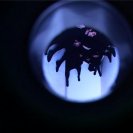As the recipients of the third annual Helen Macpherson Smith Commission, Sonia Leber and David Chesworth created a large scale sound and structure project for the cavernous main exhibition space at Australian Centre for Contemporary Art.
Human voices resonated through a series of confined corridors leading to a central, cathedral-like space. The project referenced both Jeremy Bentham's Panopticon model prison design and the Cathedral as two architectural apparatuses with a surprising aspect in common: both rely on an unseen, all-seeing observer. And both use voices in interesting ways.
Artists' statement:
We enter Almost Always Everywhere Apparent, through a door way that leads to a small anti chamber. After opening a second door and walking down a long, dimly lit passage way noises, voices and sounds become audible. At the end of this passage way we reach the centre of the work.
The central space, hub or oval atrium, radiate five other corridors of different lengths. Above the central atrium is a dark space or void that opens out into the main gallery. At the centre of the void is a video projection of a slowly rotating industrial fan, circling at different speeds.
The elements of sound can be divided into two groups. The “above” include the Royal Philarmonic Choir and samples from David’s archive. These sung sounds are often described as etheral, united, soaring and plummeting. In the corridors, the “lower” sounds remind us of real life situations, instinctive, spontaneous and random - the language of the body.
The soundscapes become louder in the centre of the work. It surround us. People will hear the “upper” voices leak in through the space and mix with the “lower” voices. Also travelling throughout the work is the sound of morse code dating back from the 1970’s. This background noise evokes a feeling of travelling through space. At the end of each corridor there are peep holes to look through. People will see a variety of images through the observation holes that are open to interpretation.The structure or space recalls that of a cathedral, departure lounge or spaceship.
Sonia and David were very interested in creating a juncture between two types of architectural ideas - the cathedral and panopticon. Jeremy Bentham, social reformist and designer of the panopticon was concerned about the environment in which prisoners were rehabilitated for society. Bentham designed a panopticon as a structure for permanent observation and surveillance. Bentham intended prisoners to be bathed in natural light. Permanent observation encouraged self-reflection to improve moral and ethical behaviour.Religious experience is strongly associated with Almost Always Everywhere Apparent through the architectural environment, images and sounds.
The influence of the omnipresent (being present everywhere at once), for example of a religious or spiritual figure observing us, is obvious in the design of the panopticon. The structure of a panopticon powerfully conveys a feeling of being watched or observed. The video aspects of Almost Always Everywhere Apparent are presented through the peepholes. There are five different visions that create ambivalence towards reality and gravity – where the audience is positioned within the work and what is being looked at.
One of the videos is of a choir filmed from above, looking down from the central dome in St. Paul’s Cathedral in London. Other images include ambiguous shadows playing over a disk of light. Another video shows people dressed in black that appear to be stuck to the ceiling of a cell. These images provide the audience with the opportunity to take them to an imaginary space removed from the structured architecture of the panopticon.




